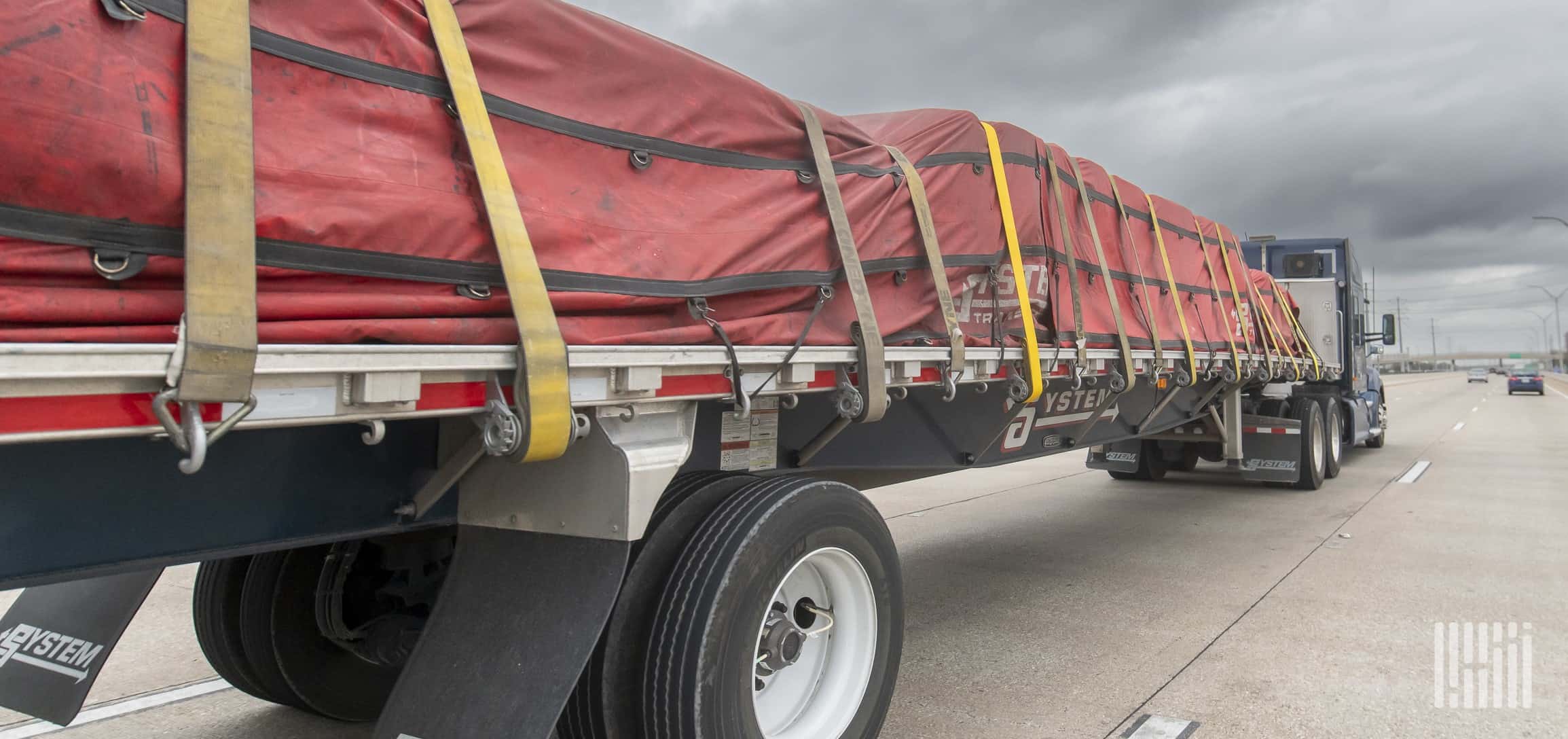Flatbeds are versatile and can carry almost any load from bees, mobile homes, machines to lumbar. Freight carriers protect their flatbed loads with a suitable tarp.
In this article, we discuss the different types of tarpaulins, and how to choose the right one. We also offer a step-by-step guide on how to tarp flatbed loads.
Which Tarp Is Right for Your Flatbed Loads?
Your cargo and environmental conditions hold the answer to what tarp is best for your flatbed load. If your cargo has sharp edges, you may need a heavy-duty vinyl tarp. The need for protection from stones, dirt, ice, and water are also important considerations in the decision on the right flatbed tarps for your cargo.
Types of Flatbed Tarps
It is essential that you choose a flatbed tarp that can offer you the best protection against natural elements and weather conditions.
Lumbar Tarp
Lumbar tarps were created to cover large and bulky loads like timber or hay. They have a flap at the end to fully cover the flatbed load. They are usually made from PVC coated polyester and the sides and tail flap usually have grommets and D rings to serve as tie-down points
Smoke Tarp
Smoke tarps cover the front of the flatbed load only. They protect the load from exhaust fumes and dust. They are often used together with a steel or lumbar tarp for additional cargo coverage.
Steel Tarp
Steel tarps are most commonly used to protect flatbed loads. They are similar to Lumbar tarps but lack the end flaps. Steel tarps also have grommets and D rings. They typically cover lower profile loads.
Machinery Tarp
Machinery tarps are designed to cover large asymmetrical items such as production and machine equipment. A good machine tarp should protect the equipment from vibration and inclement weather conditions.
Coil Tarp
The steel and aluminum industries use coil tarps to cover metal coils. These rounded tarps also protect cable coils, fitting snugly around the coil. Coil tarps have flaps at the base. The corner slits allow for the passage of the transport chain.
Parachute/Air Bag Tarp
Parachute or airbag tarps use different materials on the top and the sides. They are designed to protect the cargo from weather damage. The top is made from waterproof vinyl and the sides are made from water-resistant parachute fabric. Airbag tarps have three rows of D-rings so they are easy to secure.
Side Kit Tarp
Side kit tarps fit over the top of rigid flatbed side kits. They form the roof of the structure.
Bee Hauling Tarp
Breathable mesh bee hauling tarps ensure that you can cool and feed bees in transit. Sprinklers or reefers keep the bees cool and the mesh allows water and glucose to drip through. The tarps have reinforced anchors to prevent the bees from escaping through gaps in the tarp. Bee hauling tarps also make a good option for the transport of other live cargo such as plants.
Essential Equipment to Use to Tarp Flatbed Loads
To properly tarp a flatbed load you will need the following equipment
- Bungee Cords: Choose from two types of rubber tarp straps.
- Natural Rubber – can withstand freezing temperatures without cracking
- EPDM Rubber – better in warmer weather conditions
- Rubber Ropes: There are two types of rubber rope that can be cut to desired lengths.
- Solid Rubber – used for lightweight cargo
- Hollow Core – for heavier cargo
- Shock Cords: Versatile shock ropes consist of rubber encased in heavy-duty fabric, and they can be cut to length. Choose to add a bungee hook for various cargo types as desired.
5 Steps to Tarp Flatbed Loads
Protecting the flatbed load through appropriate tarping is the truck driver’s task. It is one of the reasons that flatbed truck drivers earn good salaries.
Step 1: Organize the Load
Make sure that the freight is evenly distributed across the flatbed. Uneven distribution of weight can result in the cargo shifting in transit, tearing the tarp, or damaging the goods.
Step 2: Choose the Right Tarp
Flatbed tarps come in various shapes and forms. Choosing the right tarp for the job will ensure that the cargo is protected from damage along the way.
Step 3: Place the Tarp on Top of the Load
Use a forklift, step ladder, or platform, to reach the top of the load. Face the back of the load and place the tarp on top of the loaded flatbed.
Step 4: Begin Tarping
Unroll the tarp evenly across the load until the cargo is fully covered from side to side.
Step 5: Secure the Tarp
Once the load is covered secure the tarp to the trailer with rubber tie-downs. Use straps to fold away any loose fabric. If you have a ratchet system on your trailer, use the hooks and secure the straps with the metal bar. If the tarp has a back flap, make sure that there is a solid seal between the trailer and the freight. Fasten the D ring.
Tarping Protects Your Flatbed Load
Flatbed tarps come in a variety of shapes and forms. Well-chosen and properly fitted tarping will protect your cargo from damage. Tarping is a skill every flatbed truck driver must have to ensure safe cargo delivery.
FAQ
The time taken will differ according to the load and the type of tarp used. Tarping a flatbed can take anywhere from 15 to 45 minutes.
You can secure a flatbed load using several ways, including rubber tie downs, bungee or shock cords. Many trailers are equipped with ratchet systems that can be used for securing the load.
Place heavy items at the base of the load. This lowers the center of gravity ensuring that the load is more stable. Evenly distribute the weight across the flatbed to prevent shifting in transit.


